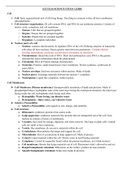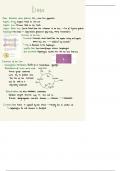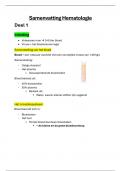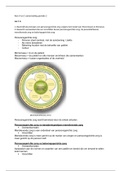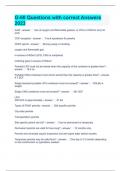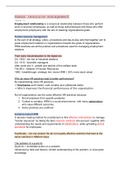Week 1. Present Value
Week 2. How to Calculate Present Values
Week 3. Value of Bonds and Common Stocks
Week 4. Valuing Government Bonds
Week 5. Risk, Return and the Cost of Capital
Week 6. Portfolio Theory and Asset Pricing
Week 7. Market Efficiency
Week 8. Forwards and Futures
Week 9. Put and Call Options
Week 10. Options Pricing Theory
Part 2: Corporate Finance - Lent Term (Dr Hongda Zhong)
Week 1. Capital Budgeting and the NPV Rule
Week 2. Real Options
Week 3. Payout Policy
Week 4. Does Debt Policy Matter?
Week 5. How Much Should a Firm Borrow I
Week 6. How Much Should a Firm Borrow II
Week 7. The Many Different Types of Debt
Week 8. Mergers, Corporate Governance and Control
Week 9. Initial Public Offerings
Week 10. Risk Management and Hedging
, 1. P RESENT V ALUE
Definitions
Discount Rate Interest rate used to compute present values of future cash flows
Bonds: interest rate, Stocks: required return rate or return/opportunity cost of capital
Present Value Value today of a future cash flow
Future Value Amount to which an investment will grow after earning interest
Discount Factor Present value of a $1 future payment
Simple and Compound Interest
Simple interest Interest is the original balance multiplied by the interest rate
Compound interest Interest must be paid on previous interest
Present and Future Values
Future Value Present Value Discount Factors
Net Present Value
NPV Rule: if NPV>0 you should invest in the project, if NPV<0 you should not invest
Optimality of the NPV rule: even inpatient individuals who want to consume today should invest if NPV>0
o Impatient individual: if return of the positive NPV project > current interest rate r, can invest his current income in
the project, borrow present value of the positive NPV project, and use proceeds of the investment to repay bank
o Decision as to which projects to invest in can be separated from the decision of when to consume
2. C ALCULATING P RESENT V ALUE
Perpetuities Annuities
An asset with a fixed nominal cashflow at the end of every An asset with a fixed nominal cash flow at the end of every
period from now until the end of time period for a finite number of periods
Perpetuities with Growth Annuities with Growth
An asset with a cashflow at the end of every period that An asset with a cashflow at the end of period that grows at
grows at rate of per period from now until the end of time rate of per period and terminates after periods
Note: we require . If , the cashflows grow more
quickly than the discount rate and sum is infinite
Quoted Interest and Effective Interest Rates
Quoted Interest Rates The K month interest rate is quoted at rate r
Always an annualised rate actual rate on a K month loan/deposit is
Effective Interest Rates The actual interest you pay on a loan or receive on a deposit on an annual basis, expressed as a %
where r is the annual nominal rate of interest and n is number of
compounding periods in a year
, Real and Nominal Interest Rates
Inflation rate: the general rise in price level in an economy
Nominal Interest rate: the rate at which the balance of a deposit grows in cash terms
Real Interest rate: the rate at which the balance of a deposit grows in purchasing power terms
If , then a deposit is losing money in purchasing power terms, and debt is shrinking in real terms
3. V ALUE OF S TOCKS AND C OMMON B ONDS
Bonds
A security under which the issuer owes the holder a debt, and is obliged to repay the principal of the bond at the maturity
date as well as interest over a specified amount of time, at fixed intervals.
Bonds are borrowing/lending arrangements formalised in contractual form
The bond issuer is raising money (borrowing)
The investor has delivered money to the issuer (a loan) and expects to see this money repaid (with interest) over time
Zero-Coupon A K-year zero-coupon bond promises the purchaser a single payment, called the face value or par value, K
Bonds years from the current date. The date of the payment is the maturity and K is the time to maturity.
Coupon Bonds A K-year coupon bond promises the investor periodic cashflows
The bondholder receives a fixed coupon payment at regular intervals until maturity
Coupon rate: the ratio of the total annual coupon payment to the face value
On the maturity date, the bondholder receives both a coupon payment and the face value
Yield to Maturity
The constant, hypothetical discount rate that when used to compute the PV of a bond s cashflows gives you the bond s
market price. The percentage rate of return for a bond assuming that the investor holds the asset until its maturity date.
Internal rate of return on a bond.
Semi-annual coupons and yields
Assume you have a bond with face value and annual coupon rate . YTM on the bond is . Coupons are paid times a year.
Assume coupons are paid every 6 months and bond has 2 years to maturity, then the price of the bond is
Yields, prices and coupon rates
Coupon rates are fixed at the issue date of a bond, while prices and thus YTMs can vary through the bond
discount rate bond yield, bond price
coupon small relative to discount rate
If coupon rate > YTM, then price of the bond > face value (above par)
If coupon rate < YTM, then price of the bond < face value (below par)
/ →
→
coupon stream not
for an
delivering market determined TVM
investor to hold me bond , price
paid < face
value received at T
Hence, hence for positive interest rates, zero coupon bonds must be priced below par

